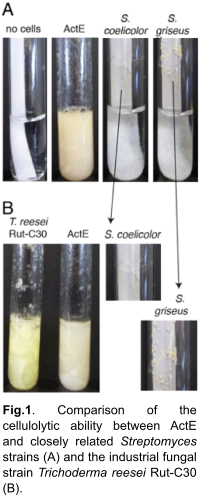Takasuka LaboratoryGenome-enabled discovery of biomass |
Discovering cellulolytic microbes!
![]() Streptomyces
Streptomyces

Wood wasps are known to contribute to forest devastation in Eurasia, North Africa, North America, and elsewhere throughout the world. Adams et al. described and evaluated the cellulolytic ability of symbiont microbes isolated from North American wood wasp mycangia (Adams et al., 2011). Of the most highly cellulolytic microbes, Streptomyces sp. SirexAA-E (hereafter ActE) was further studied for its cellulolytic ability as well as carbon-specific gene regulation (Takasuka et al., 2013). Furthermore, multiple putative key enzymes for biomass degradation were determined by secretome analysis (total of all proteins secreted into the growth medium).
In my laboratory, we are interested in isolating symbiont microbes from wood wasps found in Japanese forests. We will use these microbes to evaluate their cellulolytic abilities (Fig. 1), which can then be compared with those found in the previous studies from North America (Fig. 2). The Japanese and North American species of wood wasp probably evolved from a common ancestor, and therefore have a common symbiont microbe community structure. However, due to geographic isolation and different environmental conditions, the community structure has likely acquired interesting changes due to coevolution with each wood wasp species.

Novel isolates will be subjected to physiological and biochemical characterization, including cellulolytic capability and transcriptomic analysis. When we discover unusually high biomass-degrading microbes, we will use genetic engineering to knock out proteases and improve protein secretion to develop industrially relevant biomass-degrading strains.
REFERENCES
Adams et al., Cellulose-degrading bacteria associated with the invasive woodwasp Sirex noctilio. ISME J. 5:1323-1331, 2011
Book et al., Cellulolytic Streptomyces strains associated with herbivorous insects share a phylogenetically linked capacity to degrade lignocellulose. Appl. Environ. Micro. 80:4692-4701, 2014
Takasuka et al., Aerobic deconstruction of cellulosic biomass by an insect-associated Streptomyces. Sci. Rep. 3:1030, 2013
![]() Clostridium thermocellum
Clostridium thermocellum
The Gram-positive bacterium Clostridium thermocellum is a model anaerobic thermophile and cellulolytic organism. When grown in medium containing cellulose or cellobiose as the sole carbon source, C. thermocellum was shown to express genes encoding cellulases and other polysaccharide-degrading enzymes (Riederer et al. 2010). Furthermore, under these conditions C. thermocellum secreted a set of enzymes for efficient cellulose degradation (Gold et al. 2007).
The cellulosome, which is a mega-dalton polypeptide complex, is a unique piece of cellulose-degrading machinery secreted by this organism. Multiple cellulases and hemicellulases can be arranged in the cellulosome, and the synergy of those enzymes is expected to aid in cellulose degradation. Recently, we identified some of the enzymes from this organism to be of great interest in the biomass-degrading process (Takasuka et al., 2013 and unpublished data). In my laboratory, we will continue protein characterization for C. thermocellum as well as characterize other species of Clostridium to increase our arsenal of biomass-degrading enzymes.
REFERENCES
Gold et al., Global view of the Clostridium thermocellum cellulosome revealed by quantitative proteomic analysis. J Bact. 189: 6787-6795, 2007
Riederer et al., Global gene expression patterns in Clostridium thermocellum as determined by microarray analysis of chemostat cultures on cellulose or cellobiose. Appl. Environ. Micro. 77:1243-1253, 2010
Takasuka et al., Cell-free translation of biofuels enzymes. Methods Mol. Biol., 1118: 71-95, 2013